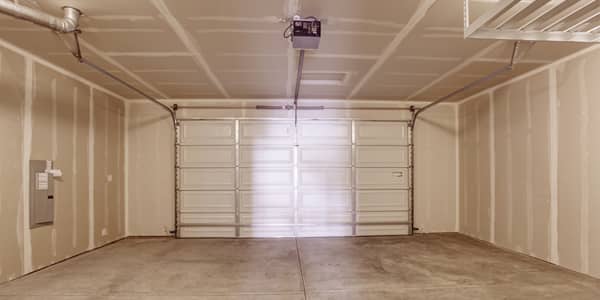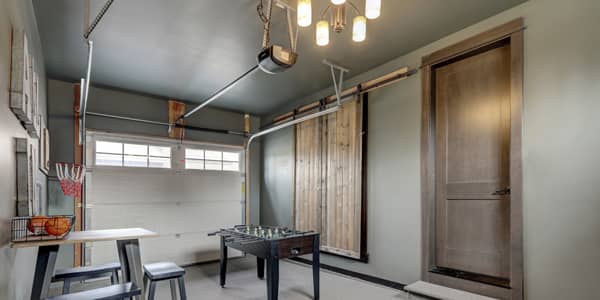St Louis - St Charles Insulation Company.


Which Insulation is Best for Garage Walls?
So you’ve decided to insulate the garage, but now your next decision will be: “what insulation should I use?”. Whether you want to make the garage itself more comfortable, or you just want to keep outside temperatures from getting into your house via the garage, blown insulation or the type of your choosing will definitely help.
The best insulation options will depend greatly on whether that space has existing drywall, or if you have exposed walls and ceiling. The most common insulation used in garages include cellulose, fiberglass, spray foam, and injection foam. It’s best to have your insulation in St. Louis MO installed by a professional to get the most benefits.
Why Insulate Your Garage?
There are many reasons why you would want to insulate your garage:
- Your garage is attached to your home and is allowing outside air to get inside the home via that common wall.
- The loft or bonus room above your garage is not maintaining a consistent temperature and has become very uncomfortable.
- The odors from the garage are getting in the house.
- You want the garage to become a more comfortable space able to maintain a regular temperature.
- You wish to utilize the area as a she-shed, man cave or playroom.
- The builder did not finish the garage with insulation and drywall, and you finally want to accomplish this task.
Insulation Options In Missouri
There are many material choices available to you when it comes to garage wall and ceiling insulation in St. Charles MO. Check them out:
1. Fiberglass
This can be installed in the garage as rolls or batts in the exposed wall cavities and ceiling. In addition, a fiberglass insulation exists that’s made specifically for insulating garage doors.
Fiberglass is a very common insulation found in a variety of homes and garages. However, the rolls and batts must be cut to fit into the wall or ceiling cavity precisely and then stapled into place. So, if you’re not planning on tearing down your drywall, fiberglass won’t be a good fit for this purpose, as it is only designed to be installed in open cavities.
And if your goal is to stop all air movement into your garage, fiberglass won’t be best because it will still allow air to move through it.
2. Cellulose Loose Fill Insulation
This can be blown into the walls and ceiling of your garage, but will only work if those cavities are covered with drywall. Your insulation contractor in St. Louis MO will blow in the loose fill insulation into the cavity via drilled holes in the drywall and then cover it up. It can also be done from the exterior through the removal of a row of siding or by drilling into the mortar.
If walls are exposed, wet-applied cellulose is best, as blown-in won’t work very well in this application. Wet-applied cellulose is combined with a bonding agent, then sprayed into the wall cavity, sticking there without the need for netting.
Just like fiberglass batting, though, cellulose still allows for air movement through the material.
3. Spray Foam and Injection Foam
These are very similar to one another because they are both foam-based products. They differ in the way they are applied.
- Spray foam insulation is applied to the open cavities to create an air seal.
- Injection foam is applied to the enclosed cavities by first drilling holes in the drywall and then injecting the foam.
Foam insulation is a more costly option, but it is a much better investment because it will save you a lot of money in energy savings over the long term.
Proper insulation is the top way to curb air escape from your home. Another thing you can do is seal cracks and openings to reduce drafts and cold spots, suggests Energy.gov. It’s important to prevent air leakage, which, if left unchecked, can contribute to moisture problems that can affect occupants’ health and the home’s durability.
Contact Addict Insulation
Not sure which type of insulation is best for your garage? No problem. Let our experts come out and assess the situation. Just give us a call at 636-233-7314 or fill out our online form.
Energy Saving BlogMissouri Insulation Company
Popular Articles
- FAQs About Insulation in Missouri
- What Areas Should You Insulate Before Winter?
- The Greatest Risks to Your Home Caused by Poor Insulation
- Why Your Utility Bills Are So High and What You Can Do About It
- Can You Put New Insulation Over Old?
- Here Are 3 Ways Your Attic Could be Contaminated
- How Home Insulation Works in the Summer
- Tips and Tricks For Summer Insulation
- How to Fix Indoor Condensation
- Choosing the Right Spray Foam Contractor
- Why You Need Power Washing This Spring
- Don't Let Air Escape Your Home
- Tips For Saving on Your Energy Bills This Summer
- Should I Install a Radiant Barrier in My Home?
- Are You Wondering if Your Attic Has Enough Insulation?
- Do I Have to Replace Wet Insulation?
- Insulating Your Sunroom
- Should You Insulate Your Outdoor Spaces?
- All About Removing Insulation
- What to Know About Insulating a Crawl Space
- How to Spot Mold in Your Wall Insulation
- How to Prevent Moisture in Your Warehouse With Spray Foam Insulation
- What Factors Cause Heat Gain?
- The Problems That Come With Improper Insulation
- Insulation FAQs
- Why Should You Check the Insulation When Buying a Home?
- Why Seal and Insulate Your Home?
- Home Insulation: Safety and Health
- Should You Remove Old Insulation During Replacement?
- Can I Stay Inside My Home During Spray Foam Insulation Installation?
- Pros and Cons of Converting an Attic
- Pros and Cons of Converting an Attic
- When’s the Best Time to Insulate Your House?
- The Difference Between Blown Insulation and Spray Foam Insulation
- Is Your Garage Loft Too Hot or Too Cold? Heed These Tips
- 6 Health Benefits of Having a Quiet Home
- Insulation Prep is Critical For Installation
- The Dangers of Removing Insulation on Your Own
- What’s the Most Eco-Friendly Insulation?
- 7 Benefits of Spray Foam Insulation
- What is the Proper Insulation For Vaulted Ceilings?
- Signs Your Crawlspace Insulation Should be Replaced
- Why You Should Insulate Your Basement Walls
- Most Effective Ways to Soundproof Your Home Office
- How to Insulate an Old House
- 4 Tips to Make Your Attic More Energy Efficient
- Attic Insulation Problems: 5 Things to Look Out For
- What Causes Condensation on Interior Walls?
- How Deep Should Your Insulation Be?
- What to Consider When Choosing an Insulation Company
- Can You Add New Insulation Layers Over Old Ones?
- When Should You Remove Insulation?
- 7 Tips For an Energy Efficient Summer
- Creating a Healthy, Comfortable and Productive Workspace When Working From Home
- Why is Roof Ventilation Just as Important as Insulation?
- Why Spring is a Good Time to Insulate Your Attic
- 5 Signs of Damaged or Insufficient Insulation
- Is the Insulation in Your Walls Making You Sick?
- Under-Insulated Areas You May Be Overlooking
- The History Of Insulation.
- Pros and Cons of Attic Insulation
- Do You Need Insulation When Finishing a Basement?
- What is Drill and Fill Insulation?
- Which Insulation is Best for Garage Walls?
- How Air is Escaping Your Home and How to Prevent It
- 10 Things You Must Absolutely Insulate Before Winter
- 5 Reasons To Not DIY Insulation
- 5 Signs of an Under-Insulated Home
- 5 Benefits of Blown Insulation
- Cellulose vs. Fiberglass Insulation
- When is Insulation Removal Necessary?
- Tips to Keep Your Home Cool This Summer
- What is the Best Insulation for a Flat Roof?
- 5 Benefits of Power Washing
- Q & A About Insulation
- Reviews
- Energy Saving Blog






